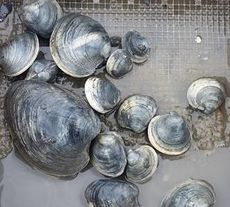
As gulf waters warm, could quahogs be the next big shellfish product?
 Courtesy / Pete Countway, Manomet
Jessie Batchelder and Marissa McMahan of Manomet take a water sample using a Niskin bottle at Robinhood Cove off Georgetown.
Courtesy / Pete Countway, Manomet
Jessie Batchelder and Marissa McMahan of Manomet take a water sample using a Niskin bottle at Robinhood Cove off Georgetown.
A new research project is trying to determine whether a species of hard-shell clam, quahogs, can thrive in enough abundance off Maine’s coast to make for a new business opportunity.
The Brunswick office of Manomet, an environmental research nonprofit headquartered in Plymouth, Mass., is partnering with the University of Maine and the Bigelow Laboratory for Ocean Sciences in East Boothbay to study the presence of quahog DNA in the water column.
Determining the level of DNA is considered useful to understanding to what extent the clams are making themselves at home in the gulf.
The study of DNA in this context is called “eDNA” or “environmental DNA,” Marissa McMahan, a senior fisheries scientist with the Brunswick branch of Manomet, told Mainebiz.
Warming water
Northern quahogs are a type of hard clam. They are referred to by different names depending on their size, according to the Department of Marine Resources. In the order of largest to smallest, they’re called quahogs (chowderhogs), cherrystones, topnecks, littlenecks and countnecks.
Historically, Maine has had a small quahog industry. But developing the fishery wasn’t practical, given that water temperatures in the gulf were at the low end of the quahog’s thermal tolerance.
But wild quahogs have been showing up more abundantly as the gulf has experienced rapid warming over the past decade, making coastal waters much more suitable for the species, McMahan said.
Wild quahogs
In 2018, Manomet supported an effort by the town of Georgetown’s Shellfish Conservation Committee to expand its quahog population by transplanting 50,000 adult quahogs to Robinhood Cove with the goal of establishing a self-sustaining population.

This summer, Manomet and its partners are using environmental DNA, or eDNA, to gauge whether or not the transplanted quahogs are spawning and producing larvae.
The presence of eDNA can be detected in tissue the animal naturally sheds in the environment.
“In the marine environment, all of that eDNA is floating around in the water column,” she said. “By taking water samples, we can get an idea of what’s there. And if we do a deeper dive, we can look at the abundance of the species.”
The goal this summer is to figure out when and where quahogs are spawning in areas where the species is known to occur.
“If we do sampling over the course of a whole season, we expect to see a spike in that signal because there will be more eDNA in the water,” she said.
That information can be used in shellfish management and conservation, she said.
“We’re seeing that quahogs are increasing in abundance,” she said. “A lot of harvesters are pivoting from soft-shell clams to quahogs.”
Farmed quahogs
The partners are also developing techniques to grow quahogs as an aquaculture species. Environmental DNA can be used to inform those efforts as well, she said. The theory is that farmed quahogs are likely reach spawning size before they reach market size. Therefore, it’s possible that farm-raised spawning quahogs could be used to help reseed the wild population, she said.

There are several quahog aquaculture operations in southern Maine, she added.
“We’re seeing it becoming more and more popular in the past two or three years,” she said.
Less vulnerable
Quahogs have always been in the gulf of Maine. But the gulf is the northern extent of their range.
“They’re well-suited to warmer water,” McMahan said. “So as the gulf warms, we think the quahog population in Maine is experiencing more favorable conditions and potentially increasing in abundance.”
The growing presence of quahogs, which have a hard shell, could be good news to shellfish harvesters, she added. That’s because Maine waters are seeing a population explosion of invasive green crabs — voracious predators that are having a devastating impact on soft-shell clam populations.
“Quahogs have thicker shell that close all the way shut, so we think they can outgrow green crabs or be less susceptible,” she said.
Larger eDNA project
The partners have worked with wild and farmed quahogs since 2019. The eDNA study is funded by a $20,000 grant awarded in January by Maine EPSCoR (Established Program to Stimulate Competitive Research), a federally funded program overseen by UMaine.
“The goal is to utilize the technology to strength our understanding of what’s happening in the ecosystem,” said McMahan.
McMahan said Bigelow’s participation is key to the study.
“Without them, this would not be possible. They’re the eDNA experts,” she said.
The sampling technology is accessible and easy.
“We go out and we take samples of water using a Niskin bottle,” she said. “But you can take water samples in anything, as long as it’s a sterile container. So it’s really accessible to a wide variety of people.”
Niskin bottles can be opened at both ends and lowered to a precise depth. A trigger seals the bottle when it’s at the desired depth, so that it doesn’t continue to collect water as it’s hauled back to the vessel.
Bigelow filters the water and processes the remaining DNA.
Bigelow senior research scientist Peter Countway is Manomet’s partner on the project.
“We’re seeing quahogs in southern and midcoast Maine now,” said McMahan. “It definitely has immediate implications for that area of the coast. But we suspect that, as the water continues to warm, we’ll see increasing abundance of quahogs likely travel up the coast.”










0 Comments